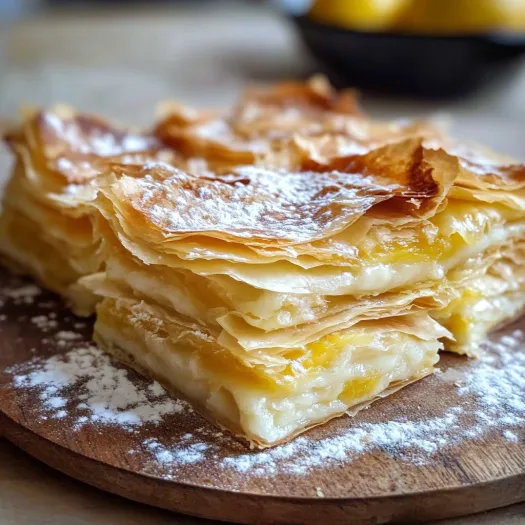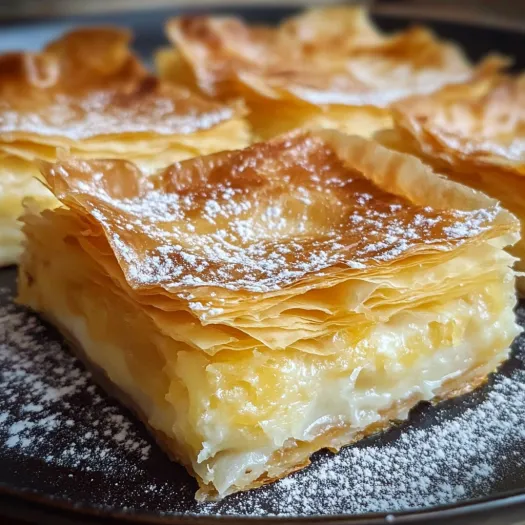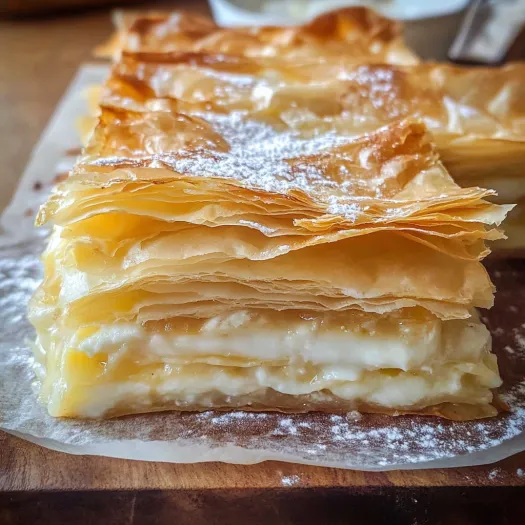 Pin
Pin
This buttery Greek bougatsa has been my weekend breakfast tradition ever since I visited Athens years ago. The contrast between the creamy vanilla custard and shatteringly crisp filo layers creates a dessert that's both comforting and impressive, especially when dusted with that signature cinnamon-sugar topping.
I first made this bougatsa after returning from a trip to Greece where I'd have one every morning with strong Greek coffee. The smell of cinnamon and butter still transports me back to those little seaside cafés.
Ingredients
- 1 package phyllo pastry sheets 450 grams Fresh is best but frozen works well when properly thawed
- 200 grams melted butter Use high quality unsalted for best flavor
- 1 liter fresh milk Whole milk creates the richest custard
- 100 grams sugar Just enough sweetness without overpowering
- 1 teaspoon vanilla extract Real extract provides the best flavor profile
- 40 grams cornstarch The secret to a perfectly set custard
- 4 large eggs Room temperature eggs blend more smoothly
- Icing sugar for serving Adds that characteristic sweetness on top
- Ground cinnamon for serving The authentic finishing touch
Step-by-Step Instructions
- Prepare the Custard
- Cook onions over medium-low heat for 8 minutes until golden this builds the flavor base. Whisk eggs and cornstarch together in a mixing bowl until completely smooth. Heat milk with sugar and vanilla in a pot until just reaching boiling point. Remove from heat and very slowly ladle the hot milk into egg mixture while constantly whisking to prevent scrambling. Pour mixture back into pot and cook while whisking continuously until thick enough to coat the back of a spoon. The custard should be silky and lump-free. Set aside to cool slightly while working on the pastry.
- Create the Base Layer
- Preheat your oven to 200°C and prepare your baking dish with a generous coating of melted butter. Working quickly with the filo to prevent drying take one sheet and gather it into a wavy formation placing it in one corner of the dish. Continue with several more sheets creating an irregular textured base that will become beautifully crispy. The ruffling technique creates more surface area for butter and better texture. Drizzle liberally with butter and prebake for 5 minutes until lightly golden.
- Add Filling and Top Layer
- Remove the partially baked base from the oven and evenly spread your cooled custard across the entire surface. For the top layer repeat the ruffling technique with remaining filo sheets making sure to cover the entire surface. The imperfect nature of the ruffles creates beautiful peaks and valleys that will brown differently creating textural interest. Drizzle the remaining butter ensuring all exposed filo receives some. Pay special attention to edges where filo can dry out quickly.
- Bake and Finish
- Return the assembled bougatsa to oven and bake for 10-15 minutes watching carefully as it can go from golden to burnt quickly. The top should be deeply golden with some darker spots for flavor complexity. Allow to cool for exactly 10-15 minutes which helps the custard set but keeps it warm. Generously dust with icing sugar then immediately follow with cinnamon creating the classic bougatsa finish. Cut into portions while still slightly warm for best texture.
 Pin
Pin
My grandmother taught me the special ruffling technique for the filo which creates more texture than simply layering flat sheets. She always said the imperfections in the filo are what make homemade bougatsa special and create those perfect little pockets where butter pools and creates extra crispiness.
Storage Guide
Bougatsa is truly best enjoyed fresh from the oven when the contrast between crispy exterior and warm custard is at its peak. However if you need to store leftovers keep them in an airtight container in the refrigerator for up to 2 days. To revive reheat in a 180°C oven for 5-7 minutes which will restore some crispness to the filo. Never microwave as this will make the pastry soggy and ruin the textural contrast that makes bougatsa special.
Ingredient Substitutions
While authentic bougatsa uses specific ingredients you can make adjustments if needed. If cornstarch isnt available substitute with all purpose flour but double the amount. For a dairy free version use almond milk and dairy free butter though the flavor will be slightly different. Traditional Greek bougatsa uses semolina instead of cornstarch which gives a slightly grainy but authentic texture if you want to try the most traditional version. The vanilla can be replaced with orange zest or lemon zest for a citrus variation common in some Greek regions.
The Cultural Significance
Bougatsa has deep roots in Greek cuisine particularly in northern Greece and the city of Thessaloniki where specialized bougatsa shops called bougatsatzidika serve this treat all day long. Originally brought to Greece by refugees from Asia Minor in the early 20th century it has become a beloved national dish. In Greece bougatsa is traditionally eaten for breakfast but also as a midday snack or dessert. The distinctive cinnamon sugar topping is what distinguishes sweet bougatsa from savory versions which might contain cheese or minced meat instead of custard.
 Pin
Pin
Frequently Asked Questions About the Recipe
- → Can I prepare the custard filling in advance?
Yes, you can prepare the custard filling up to 24 hours in advance. Store it covered in the refrigerator with plastic wrap directly touching the surface to prevent a skin from forming. Allow it to come to room temperature before assembling the bougatsa.
- → How do I prevent the filo pastry from drying out while working with it?
Keep the filo sheets covered with a slightly damp kitchen towel while you work. Only remove the sheets you're actively using, and work quickly. The key is maintaining moisture without making the filo wet.
- → Can bougatsa be frozen?
Yes, bougatsa can be frozen before or after baking. To freeze unbaked bougatsa, assemble it completely, wrap tightly in plastic wrap and aluminum foil, and freeze for up to 3 months. Bake directly from frozen, adding 10-15 minutes to the baking time. Baked bougatsa can be frozen for up to 1 month and reheated in a 350°F oven until warm.
- → What can I substitute for cornstarch in the custard?
All-purpose flour can be substituted for cornstarch in a 2:1 ratio (so use 80 grams of flour instead of 40 grams of cornstarch). This will produce a slightly different texture, but will still thicken the custard effectively.
- → How do I achieve the perfect crispy texture for the filo?
The key to crispy filo is generous brushing with melted butter between layers and ensuring your oven is properly preheated. The initial 5-minute pre-bake of the bottom layers also helps create a crisp base that won't get soggy from the custard.
- → Can I make a savory version of bougatsa?
Absolutely! Traditional savory bougatsa is made with a cheese filling, typically using a combination of feta and ricotta or mizithra cheese. You can omit the sugar and vanilla from the recipe and add herbs like mint or dill to the cheese filling.
